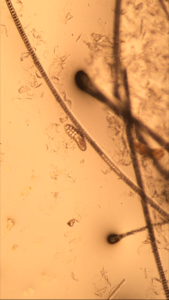Mange is a type of skin disease caused by parasitic mites which can lead to painful and uncomfortable symptoms in dogs. For this reason, it is important to recognize the signs and symptoms of the condition so your pet can be correctly diagnosed and treated.
Types of Mange
Demodectic mange and sarcoptic mange are the most common types of mange in dogs. They are caused by two separate species of mite which infest the skin of dogs and other animals. Both types of mange can be confined to one area of the body (localized) or spread throughout the body (generalized).
Demodectic Mange
Demodectic mange is caused by the demodex canis mite. This type of mite is normally found in small numbers on the skin of healthy dogs. Mange infestation occurs when a pet’s immune system is compromised. When this happens, mites can colonize the skin in large numbers and cause a variety of painful skin problems.
Demodectic mange is common in older dogs with weakened immune systems caused by underlying health conditions. It is also often seen in younger dogs with underdeveloped immune systems. This type of mange is not contagious to other animals or humans.
Sarcoptic Mange
Sarcoptic mange is caused by the canine scabies mite. Unlike demodectic mange, it is highly contagious to both pets and humans.
Any dog that comes into contact with an infected animal is at high risk of contracting sarcoptic mange. The condition is spread easily in dog parks, boarding facilities, animal shelters, and other places where large numbers of animals gather.
Symptoms of Mange
Please visit your veterinarian as soon as possible if your dog displays any of the following common symptoms of demodectic or sarcoptic mange.
Symptoms of Demodectic Mange
- Hair loss and bald patches
- Scaling and crusting
- Redness and inflammation
- Itchiness
- Oily skin
- Sores
Symptoms of Sarcoptic Mange
- Extreme itchiness
- Hair loss
- Sores
- Red and scaly skin
- Scabbing
- Thickening of the skin
Diagnosis of Mange
Your veterinarian will ask you a series of questions about the onset of your pet’s symptoms. They will then perform a thorough physical examination to check for signs of mange.
If mange is suspected, skin scrapings will be taken for microscopic analysis. It may be necessary to take multiple scrapings from different parts of the body to reveal the presence of mites, eggs, or larvae.
Your veterinarian may also recommend other diagnostic tests such as bloodwork and stool samples to assess your pet’s overall health and rule out other causes of their symptoms.
Treatment of Mange
Your pet’s treatment will depend on the severity and type of mange. The following treatment options are commonly recommended for demodectic and sarcoptic mange.
Treatment of Demodectic Mange
If your dog has mild symptoms or localized demodectic mange, your veterinarian may recommend letting the condition resolve itself. If mange is generalized or your pet’s symptoms are more severe, topical anti-mite creams, medicated dips, or other anti-parasitic medications are routinely prescribed. Antibiotics may also be necessary to address secondary infections.
Treatment of Sarcoptic Mange
Dogs with sarcoptic mange will usually need to be washed and trimmed before treatment so medication can reach the level of the skin. Commonly prescribed medications include spot-on treatments, creams, and medicated dips. Antibiotics will also be prescribed if your pet has a secondary infection.
Since sarcoptic mange is so contagious, it is important to treat all dogs in the house and thoroughly wash bedding and clothing your pet may have contaminated. This will help minimize the risk of reinfestation.
Prevention of Mange
It is possible to reduce the risk of your pet contracting mange by supporting their immune health. Always feed a nutritious, balanced diet and provide plenty of exercise to keep your dog happy and healthy. It is also a good idea to speak to your veterinarian about supplements and anti-parasitic medications that can protect against mange. Finally, make sure to keep your dog’s environment as hygienic as possible and avoid unnecessary contact with animals that may be infested with the canine scabies mite.


